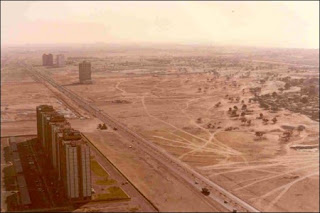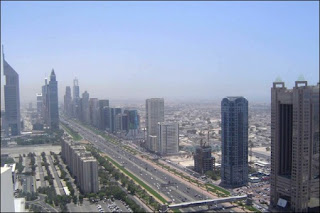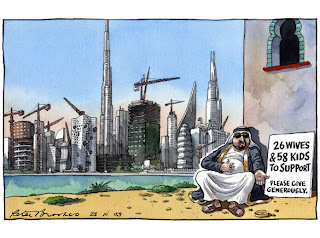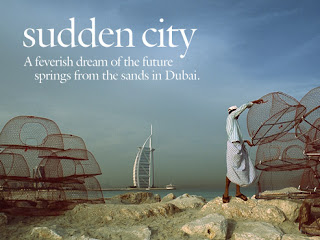Just to add salt to the wounds of the Dubai government, I was surprised to read that The World islands are sinking into the sea. A case brought forward to the courts against the developers understand that the sand on the 300 islands are eroding!
The World islands were developed to be sold to millionaires with bespoke villas. However, all construction has stalled and it is not known when the plans will resume.
The Rising and Sinking of Dubai Properties
Friday 2 March 2012
Property Crash!
In 2008, the global credit
crunch had arrived. Dubai
In 2009, Dubai World, a state
owned real estate company behind the property expansion, announced to its
creditors it had problem with its debt repayments. This news caused shockwaves
which accelerated the decrease in prices.
Around 50% of real estate
properties, summing up to £400bn, have been put on hold or cancelled.
Residents living on Palm Jumeriah,
which is also home to celebrities such as Michael Schumacher and David Beckham,
have seen their apartments or villas drop by 60% in a couple of months.
Investors struggling to meet their
debt payments have been trying to sell their luxury cars. Under Dubai’s strict
law, if one defaults on its debt or a cheque is bounced, they will be
sentenced. Therefore any expatriate in financial trouble will most likely flee
the country taking the next available flight home
The government has admitted it now has one of the
highest levels of debt per capita in the world!
A more detailed impact of the people of Dubai can be seen in this video link
Skyscapers Predict Crashes??
Having
studied finance and economics for several years, I understand the theory behind
the property collapse. However, I was not expecting to read that constructing
the world’s tallest building can have severe consequences.
The Skyscraper Index, which was first introduced by an economist named Andrew
Lawrence, stated that the construction of the world’s tallest building can
offer an insight into the next financial crisis to come just around the corner.
Dubai aka "Mushroom City"
In the UK
Some
impressive structures have been created such as the 400m indoor ski slope.
While it may b -4°C indoor, it is usually 45°C outdoor. Another
recognisable structure is The World which are man made islands designed to
reflect the shape of the globe. Dubai Millennium
Bridge in London
From 2002 to 2008, property
prices increased 500% and became one of the fastest growing cities in the world
hence Dubai is dubbed the “Mushroom City Dubai
The Property Boom
So how did the recent property boom began? How did Dubai change from becoming mainly covered in sand to many exciting, high rising structures?

Sheikh Zahed Road, the main road in Dubai in 1991

Sheikh Zahed Road, the main road in Dubai in 2005
There are two main reasons.
Firstly, the government continued to invest in real estate
to ensure Dubai would become a commercial hub.
Secondly, investors could get access to credit very easily
due to low interest rates worldwide.
It all began in May2002 when Sheikh Mohammed changed the law
which allowed foreigners to own property in certain areas of the city. Before
only Emirati nationals could own property. It could not rely its oil reserves,
which only accounts for 6% of its income.
It needs to continue to attract foreigners by boosting its tourism
sector and commercial activity. One way to achieve this is to follow the philosophy
of “Build it and they will come”.
Around the same time as the new legistslation was introduced,
the Palm Jumeriah proposed plans were announced and all 4,000 off-plan
properties were sold within 72 hours.
All 700 off-plan villas were sold out in a few hours when
the prestigious residential property called “The Meadows” was released.
The change in the law opened up Dubai
Gareth Campbell (2012) describes the investors in the British Railway Mania were myopic but rational. Myopia is when people based their investment decisions on the short-term and are unable to predict what may happen in the long term. This behaviour applies to the property investors in Dubai as many off-plan properties were bought and sold several times before it was sold to the people who decided to live there . They were only concerned on how to make a quick profit. Believing prices would continue to rise, they would purchase more and more property in the belief they would sell to make a quick profit.
Gareth Campbell (2012) describes the investors in the British Railway Mania were myopic but rational. Myopia is when people based their investment decisions on the short-term and are unable to predict what may happen in the long term. This behaviour applies to the property investors in Dubai as many off-plan properties were bought and sold several times before it was sold to the people who decided to live there . They were only concerned on how to make a quick profit. Believing prices would continue to rise, they would purchase more and more property in the belief they would sell to make a quick profit.
So where had these investors come from and where were they
getting their money from? Majority of the investors came from abroad; only 28%
of buyers were Arab nationals so there was a huge reliance on foreigners to
make Dubai prosperous. In 2002, interest rates around the world were low. For
example, in the US, the Federal Reserve deliberately kept interest rates low so
credit could easily be accessed.
Allen and Gale (2000) explained that financial liberalisation can be a big factor in why asset prices such as the housing market may rise and fall sharply. When there is a credit expansion, investment and consumption increase so asset prices increase. When there is a credit squeeze, investments stop and asset prices come to a crash. I will show you later that even Dubai can’t avoid the property crash.
Allen and Gale (2000) explained that financial liberalisation can be a big factor in why asset prices such as the housing market may rise and fall sharply. When there is a credit expansion, investment and consumption increase so asset prices increase. When there is a credit squeeze, investments stop and asset prices come to a crash. I will show you later that even Dubai can’t avoid the property crash.
Thursday 23 February 2012
Burj Al Arab
On 7 October 1990, Sheikh Rashid passed away. You would
think the ambition to put Dubai on the map would die too and that would be an
end of an era like Saddam Hussein’s death in Iraq but you would be wrong if you
thought this. Sheikh Maktoum bin Rashid Al Maktoum would become the new ruler
and continue the legacy left by his father. His focus would be the creation of
world class properties that would put Dubai firmly on the globe.
Everyone knows when they see Burj Al Arab, meaning Tower of
the Arabs, it reminds them of Dubai and this was the exact purpose behind the
design of the only seven star hotel in the world. It didn’t take long for the
building to open in 1999 to become the tallest hotel in the world at the time.
The
cost is rumoured to be so high to build and run that it will never make a
profit. One night alone will set you back £12,000. When I arrived at this
iconic structure in 2010, I realised it would cost me $55 just to get a tour,
hence the only picture you see is me standing outside the hotel! At first I
thought the idea of having to pay in for a tour was not right but then I
quickly realised, if you did spend £12,000 a night, would you really want curious tourists walking around freely and having a picture of your Ferrari posted all
over Facebook!
Anyway, thanks to technology these days, I can show you what you can expect to see with your money via this video!
Monday 13 February 2012
Father of Dubai
I was watching football the other day and was reminded about the success of the English football team in 1966 when they won the World Cup. On the same year, Dubai had struck gold too as oil was
discovered off its coast which helped fuel its rapid development.
Sheikh Rashid had a famous saying
 He was aware its oil reserves would run out in
about 50 years and Dubai would have to rely on other sectors of the economy for
income. This inspired the development of several infrastructure projects to
make Dubai a vital trading hub in the Middle East.
He was aware its oil reserves would run out in
about 50 years and Dubai would have to rely on other sectors of the economy for
income. This inspired the development of several infrastructure projects to
make Dubai a vital trading hub in the Middle East.
Sheikh Rashid had a famous saying
“My grandfather rode a camel, my father rode a camel, I drive a Mercedes, my son drives a Land Rover, his son will drive a Land Rover, but his son will ride a camel”.
 He was aware its oil reserves would run out in
about 50 years and Dubai would have to rely on other sectors of the economy for
income. This inspired the development of several infrastructure projects to
make Dubai a vital trading hub in the Middle East.
He was aware its oil reserves would run out in
about 50 years and Dubai would have to rely on other sectors of the economy for
income. This inspired the development of several infrastructure projects to
make Dubai a vital trading hub in the Middle East. With the help of rising oil prices in the 1970s, one of the first man-made projects was Port Rashid, named after the Ruler of Dubai himself, was opened in 1973 where the biggest ships at the time could use its five berth container terminals. An additional port was also built at Jebal Ali with 66 berths completed by 1983. Not only is this the largest port in the Middle East but to this day it is the largest man-made port ever built! During the same period, Dubai Dry Docks were being constructed which opened in 1979 with a capacity of 1 million ton. Additionally in 1978, the Dubai World Trade Centre was under construction.
Not only were the creation of the ports
very successful as they allowed a link between the Far East and the Western
hemisphere, they were also very ambitious. To make us understand how ambitious
the Sheikh was, the cost of Palm Jumeirah or Palm Island, which is a man-made, residential, palm shaped island, is evaluated at $12 billion. The cost of the Jebel Ali port is estimated
at $9 billion if it was built today.
Subscribe to:
Posts (Atom)





